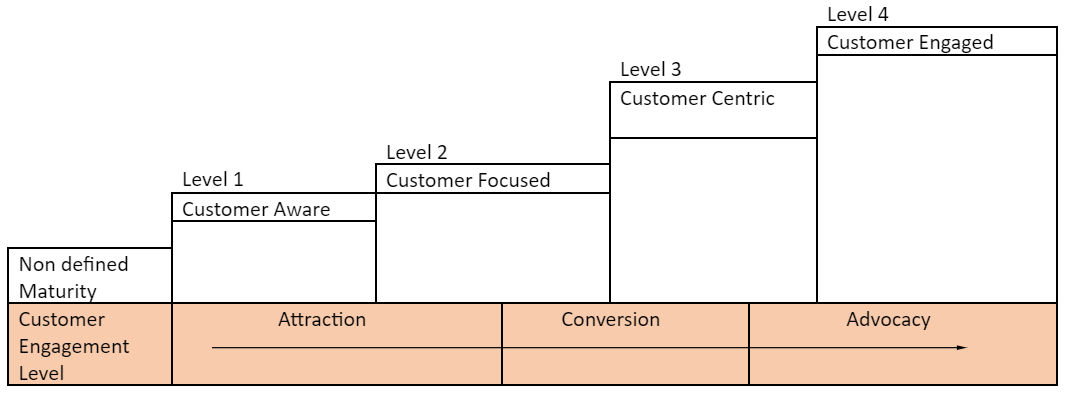The People Imperative
The value and necessity of the role of employees in resolving the service quality/customer experience equation has always been well understood. The Covid Pandemic brought this factor into even sharper relief as organisations were required to develop new operational processes and methods to meet the needs of both employees and customers.
A challenge that was met with a highly variable range of success. Part of the reason for some of the less successful approaches may well have been due to neither employer nor employees developing a working relationship based on mutually accepted Models designed to deliver a mutually beneficial outcome.
As the ratio of more digital to less human customer contact increases so the importance of every customer contact with a real employee producing a positive experience is further increased.
In recognising this rising imperative, The International Customer Experience Institute (ICXI) has developed this new Framework as the foundation and structure to assist organisations to dramatically improve Employee Happiness and Wellbeing.
The International Employee Happiness and Wellbeing Framework – EHWF2024
Its aim is to provide organisations of all sizes in all sectors with the means and methodology to create the most positive and productive operational environment possible for the mutual benefit of the customer, the employee, and the organisation.
Vector 6 – Employee Happiness and Wellbeing Model
The research and development process looked at multiple sources including earlier work on human behaviour from the likes of Frederick Hertzberg, Abraham Maslow, Douglas Macgregor and Dr Michael O’Connor and onto some of the more recent work by several leading Employee Happiness expert individuals and organisations, plus (co-founder of ICXI) Robert Keay’s 6M’s model (developed in 2015 and included within his book on Customer Happiness on the Horizons, as well as the independent contribution of happy employees, all of which contain valued and valuable insights into the relationship and engagement between organisation, employee and customer.
It is an oversimplification to see the employee/customer happiness relationship as a simple linear equation in which the employee is happy, the customer is happy, the boss is happy, and as a result of which good tidings and benefits accrue to all concerned. In practice such relationships are far more dynamic and complex. Their management must be more deeply understood and more carefully managed. The Framework that has been designed to address this potentially complex relationship into clear manageable sections for the Vector 6 Employee Happiness and Wellbeing Model shown in following pages.
As stated, the Institute has engaged and involved experts, academics, employees, HR, and other related professionals in the production of this new Model, and we are confident that all the relevant criteria to deliver Excellence in Employee happiness and Wellbeing are included within this Model.
The Vector 6 Model
The Vector 6 Model identifies the core CRITERIA that are critical in maintaining a positive, energised, effective and respectful relationships and partnerships between employer and employee for the mutual benefit of each of these parties and their customers. It is capable of measurement and the results can be analysed by any vertical or horizontal organisational sector and provide for all parties’ guidance for performance analysis and consequent continual Improvement.
The Core Criteria elements of the model are:
- VALUES LED LEADERSHIP
- ENVIRONMENT AND CLIMATE
- CAREER CONTROL
- TEAMWORK LED SUPERVISION
- ORGANISATIONAL EFFECTIVENESS
- REWARD AND RECOGNITION
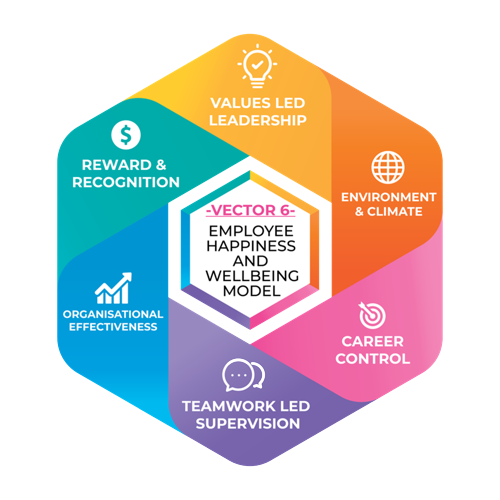
Vector 6 Model – Structure
EHWF2024 Implementation Process
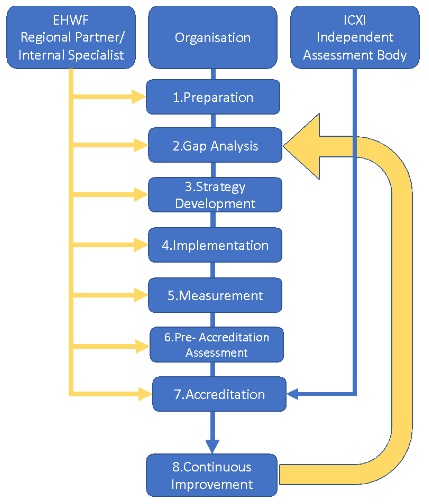
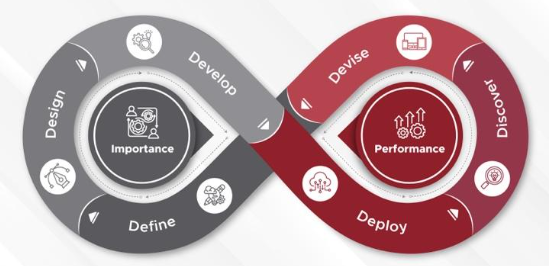
The Six Dimensions of Implementation Model
The model, represented as an infinity visual, is a step-by-step non-restrictive framework that seeks to assist organisations to develop a continuing improvement process within each of the five dimensions of the ICXI 5P’s Customer Experience Management Model. Organisations can use it as a guide to interrogate and analyse wherein these areas there is scope for improvement.
The model is composed of six dimensions that are closely integrated and linked, three of these are categorised under ‘Importance’ and three are under ‘Performance’.
The 6 Dimensions
The ‘Importance’ dimensions cover how an organisation understands its customer and market needs and expectations to align and develop the organisation to fulfil them. The ‘Performance’ dimensions are how the organisation delivers the developed experiences and continuously analyses voice of customer feedback to innovate and improve experiences.
The infinity starts at the “Define” dimension and is a continuous dynamic loop of analysis development delivery and measurement.
The dimensions of the Model answer the fundamental questions surrounding customer experience management
Define
What do customers expect?
Design
What experiences can be delivered?
Develop
How will it be achieved?
Deploy
How will it be implemented?
Discover
Has it worked?
Devise
What innovations are required?
Each of the elements of the six dimensions has a definition to explain its objective (objective statement); the definition is then followed by a detailed explanation that describes the expected activities that lead to its achievement (maturity indicators).
AIMS
The simple aim of the model is to help organisations to better understand what is important to their existing or target customers and to measure their performance in those key areas. The performance gaps providing the content for a performance improvement programme that becomes an ongoing contributor to the development and maintenance of competitive advantage and customer loyalty.
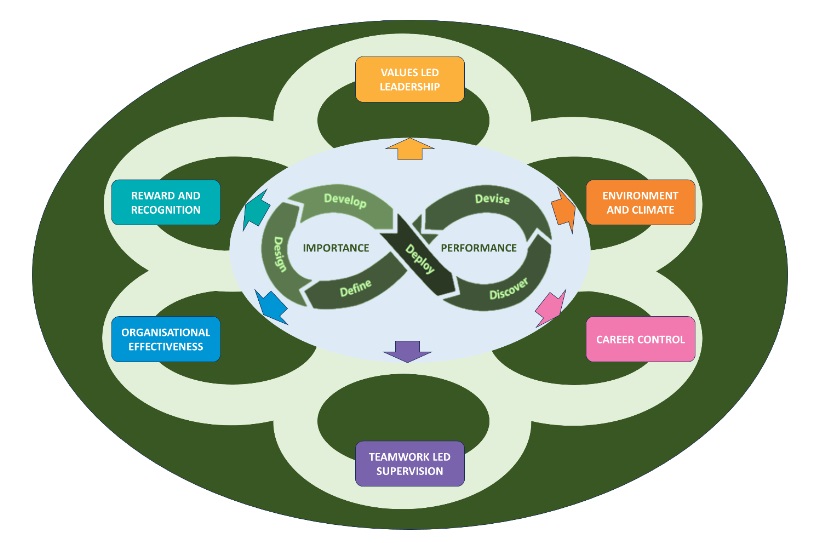
6D Model – Maturity Scale
The maturity scale concept is an implementation target and assessment methodology that allows organisations to determine their present status versus their targeted maturity objective and plan the work towards its achievement.
This 6D Model maturity is based on a maturity categorisation aligned with other global maturity scales and models.
Organisations can conduct a detailed comprehensive review and assessment to analyse the present maturity status within each of the dimensions and elements within it.
Assessment using the Maturity Scale
The ICXI 6D Model maturity scale is an assessment approach that organisations striving towards customer engagement use to determine their maturity level of their customer experience strategy.
The assessment scoring can also be used by organisations conducting self-assessment and seeking benchmarking with others.
All of the elements within each of the dimensions have its own score. By reviewing the individual level of each element, the organisation can identify areas of strength and weakness and develop an improvement plan to prioritise actions designed to reinforce areas of strength and address areas of weakness.
The underlying scoring system of the maturity scale is based on the six dimensions of the Model weighted according to the relative importance of its components.
There are 1,000 points distributed among the 6 dimensions of the Model.
40% of the assessment scoring is based on the Importance dimensions and 60% are allocated to the Performance dimensions.

